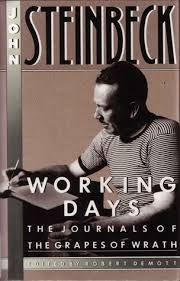
June 17, 1938
“Hope my nerves aren’t weak because they have a long haul ahead….Begin the detailed description of the family I am to live with for four months. Must take time in the description, detail, detail, looks, clothes, gestures. Ma very important. Uncle John important. Pa very. In fact all of them are important. Got to take it slowly. I don’t care how long it is. We have to know these people. Know their looks and nature. Must.” Working Days: The Journals of The Grapes of Wrath, 1938 – 1941, John Steinbeck
 I’ve just finished reading Louise DeSalvo’s wonderful The Art of Slow Writing. I like slow cooking, slow cities, slow flowers, and slow living, so of course I had to see what slow writing is all about.
I’ve just finished reading Louise DeSalvo’s wonderful The Art of Slow Writing. I like slow cooking, slow cities, slow flowers, and slow living, so of course I had to see what slow writing is all about.
In her book, Louise looks closely at every stage of the writing process and what it takes to achieve our best work.
Slow down, she recommends. Good writing cannot be rushed.
Slow writing is not a new trend: the best writers have always been slow writers.
Zadie Smith, Elizabeth Gilbert, Jo Ann Beard, Virginia Woolf, Michael Chabon, Henry Miller, D.H. Lawrence, Jeffrey Eugenides, Ian McEwan – DeSalvo synthesizes the wisdom of these and many other writers who have spoken frankly about what it takes to go deep into our creative process to achieve stellar writing.
Louise shows us her writing process, too (she has published several memoirs and other books), and shares anecdotes about getting stuck and how she eventually found a path forward.
 For those of us writing a memoir or other book-length work, De Salvo recommends studying Steinbeck’s two published writing journals: Working Days: The Journals of the Grapes of Wrath and Journal of a Novel: The East of Eden Letters. She encourages us to keep our own writing journals, too, for long projects.
For those of us writing a memoir or other book-length work, De Salvo recommends studying Steinbeck’s two published writing journals: Working Days: The Journals of the Grapes of Wrath and Journal of a Novel: The East of Eden Letters. She encourages us to keep our own writing journals, too, for long projects.
I’ve begun skimming Working Days. Notice in the opening quote above that John Steinbeck reminds himself to take it slowly, and give each character his or her due.
It’s surprising to see how lost Steinbeck sometimes felt and how he used his writing journal to keep himself going. Here are more excerpts:
September 7, 1938
“I’m afraid this book is going to pieces. If it does, I do too. I’ve wanted so badly for it to be good….if only I wouldn’t take this book so seriously. It is just a book after all, and a book is very dead in a very short time. I’ll be dead in a very short time too. [Steinbeck would live another 30 years.] So the hell with it….I must go on. I can’t stop…..How did I ever get started on this writing business anyway? To work.”
January 29, 1941
There are so many things to go into this book. An astonishing number of things. But I’ll get them all in if I just relax and get them in day by day and only worry about the 2000 words of each day’s work. That’s the only way to do it, I have found. But damn it, I have to learn it over again every time.
January 30, 1941
My head is a grey cloud in which colors drift about and images half-form. I’m bludgeoned and feel beaten by many little things. And I can’t figure answers to them. Maybe some people think clearly all the time and make nice decisions. I don’t know. But I feel very lost and lonely.
 The Grapes of Wrath won the Pulitzer Prize in 1940, and contributed to Steinbeck’s winning the Nobel Prize in 1962.
The Grapes of Wrath won the Pulitzer Prize in 1940, and contributed to Steinbeck’s winning the Nobel Prize in 1962.
It has stirred up a great deal of controversy, too. According to Robert Demott, editor of Working Days, The Grapes of Wrath has been “banned repeatedly by school boards and libraries, and denounced by right-wing ministers, corporate farmers, and politicians as immoral, degrading, and untruthful.”
A Free Roundtable with Louise DeSalvo
If you’re interested in finding out more about stages of the writing process and how to begin and successfully complete a book-length work, consider registering for the National Association of Memoir Writers free Roundtable (teleconference) with Louise DeSalvo on Thursday, March 5 at 7 pm EST, 4 pm PST. I’ll be in the audience.









